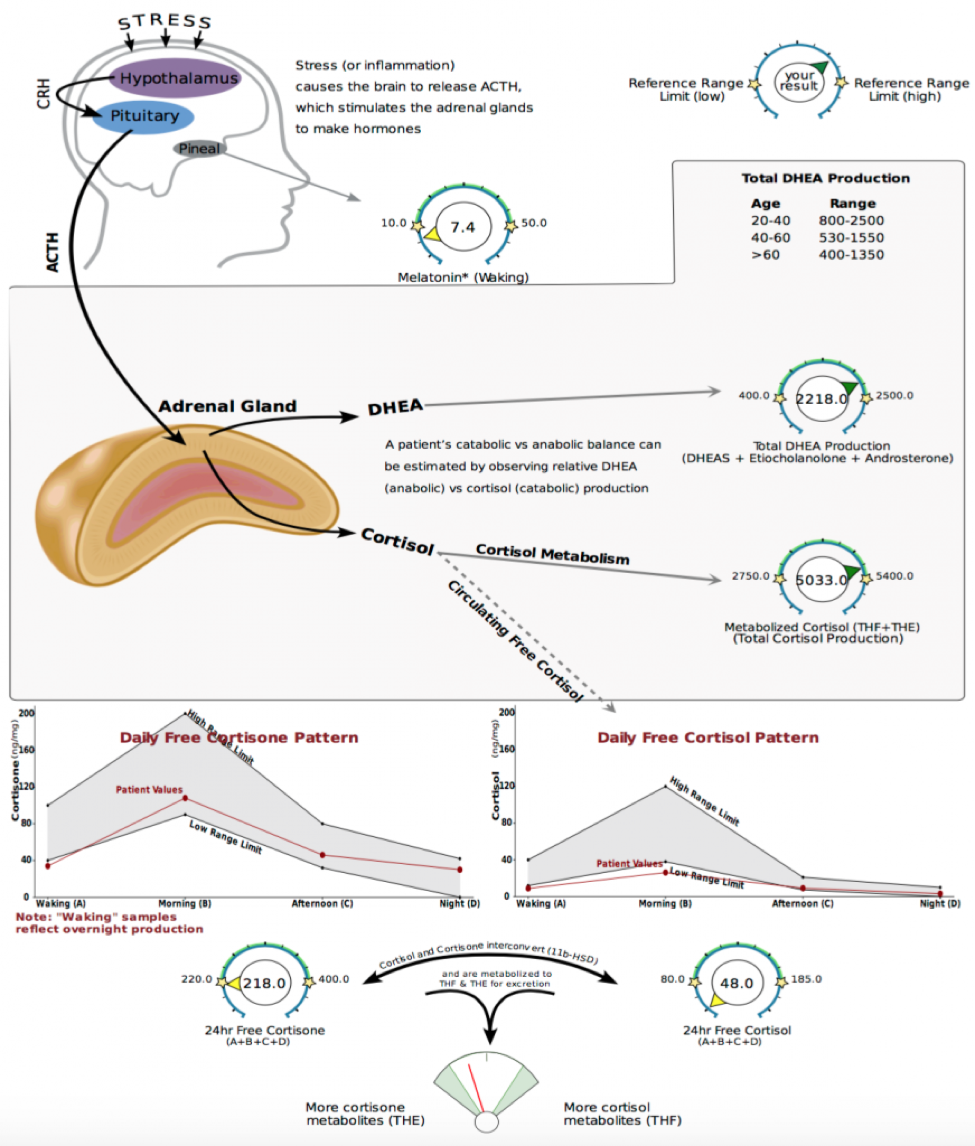![]()

The Dutch Test
HPA axis dysfunction (HPA-D) is the scientific term for the popular syndrome known as “adrenal fatigue.” It refers to a combination of signs and symptoms that include fatigue, sleep disruption, poor exercise tolerance and recovery, low libido, brain fog, weakened immune function, and reduced stress tolerance.
HPA axis dysfunction is caused by many different aspects of the modern lifestyle, including poor diet, sleep deprivation, chronic stress, lack of (or too much) exercise, and inflammation. HPA axis dysfunction affects nearly every cell and tissue in the body.
Testing For HPA Axis Dysfunction
Traditionally, saliva tests are used to measure the adrenal stress index and this is problematic for a number of reasons. Often times, the directions on saliva tests instruct individuals to give their first sample between 6-8 am, without regard to the time one wakes up. More than 50 percent of the cortisol we produce in a given day is produced within 30 to 45 minutes upon waking. This is referred to as the Cortisol Awakening Response (CAR).
For example: A patient orders a saliva test and follows the instructions. They wake up at 6 a.m. but they don’t test their cortisol until 8 a.m.; they would miss the cortisol produced during the CAR (50% of the cortisol produced in a day!), and the estimation of total cortisol production that’s largely derived from that first morning sample is going to appear low.
Saliva tests are also less than ideal because they do not capture cortisol metabolites (which best represent total cortisol production) and cortisone results, which can be very helpful. Saliva test only analyzes free cortisol, which represents only 3-5% of total cortisol in the body.
What is the DUTCH Test?
This is why at Dr.Jockers.com, we have decided to offer The DUTCH Test™ — Dried Urine Test Comprehensive Hormones. Precision Analytical developed this new method of urine cortisol measurement that involves collection of a small amount of urine on filtered paper four times a day.
In this way, the DUTCH Test™ is able to estimate diurnal production, like saliva, but also provide information on both total free cortisol and overall cortisol using metabolites, as well as free cortisone and metabolized cortisone.
Advantages of the Dutch Test
The DUTCH Test™ is well-recognized for its ease-of-collection, coupled with comprehensive reporting that is not available from other laboratories. The DUTCH Adrenal provides free cortisol patterns that parallel saliva with the addition of metabolite measurements for an improved marker for total cortisol production.
The cortisol metabolites in the adrenal section are among the commonly-highlighted markers appreciated by practitioners. They offer a much more complete view of the HPA axis than the traditional saliva tests, which only measure free cortisol.
Importance of Free and Total Cortisol
It is important to measure the amount of free cortisol as well as total cortisol produced in order to get a full view of cortisol production and use in the body. The amount of total cortisol produced and the amount of free cortisol available can be very different in some scenarios.
Measuring both allows for insight into the rate of cortisol clearance/metabolism. For example, higher levels of metabolized cortisol (compared to free cortisol) are often seen in obesity where adipose tissue is likely pulling cortisol from its binding protein and allowing for metabolism and clearance.
The adrenal gland has to keep up with this cortisol sequestering and excretion, so cortisol production is often quite high (as seen in the levels of metabolized cortisol) even though free cortisol does not correlate positively with adipose tissue or BMI. This insight is quite helpful for those looking to lose belly fat and suspect cortisol/stress is a major factor.
These patients are often misdiagnosed as having low cortisol production when only free cortisol is measured. Increased cortisol clearance may also be seen in hyperthyroidism and is suspected to be part of the chronic fatigue story as well.
Hypothyroid Pattern
In patients with low thyroid, the opposite pattern is often seen. When the thyroid slows down or if there is peripheral hypothyroidism where free T3 cannot get into the cells, the clearance (or metabolism) of cortisol through the liver slows down.
As a result, free cortisol starts to increase and may show up elevated on the DUTCH Test™. The literature is more definitive for lower metabolized vs. higher “free”.
The metabolized cortisol and free cortisol markers are important to use both together and separately in order to tell a more detailed story about the patient. Metabolized cortisol answers the question of how much cortisol is being made in total and clearing through the liver. Whereas free-cortisol results tell us how much cortisol is free to bind to receptors and allows for assessment of the circadian rhythm.
The metabolites of cortisol also give insight into the activation and inactivation (to cortisone) of cortisol. Having the most comprehensive testing available with the DUTCH Test™ allows for a more complete look at the overall HPA-axis picture. This in turn leads to better treatment and clinical outcomes.
The DUTCH Adrenal provides free cortisol patterns that parallel saliva with the addition of metabolite measurements for an improved marker for total cortisol production. This test is run on LC-MS/MS: the most accurate way to test cortisol and metabolites!
How to Perform the Dutch Test
Traditionally, urine cortisol has been measured in a 24-hour collection, where a patient just carries a jug around with them, for 24 hours at home. Urine contains free cortisol, but it also contains many cortisol metabolites, like cortisone or 5-alpha- tetrahydrocortisol, 5-beta-tetrahydrocortisol, tetrahydrocortisone, etc. Assuming normal cortisol clearance rates, most cortisol synthesized by adrenal glands will be metabolized in the liver and cleared in the urine within 90 minutes.
So, urine cortisol is a reflection of cortisol production over the 90 minutes prior to when the sample was collected, if you’re doing a spot urine cortisol test. Precision Analytical developed a new method of urine cortisol measurement called DUTCH— Dried Urine Test Comprehensive Hormones—and this involves collection of a small amount of urine on filtered paper four times a day, and in this way, the DUTCH test is able to estimate diurnal production, like saliva, but also provide information on both total free cortisol and overall cortisol using metabolites as well as free cortisone and metabolized cortisone.
Summary:
The pros of the DUTCH test are that it has most of the advantages of saliva: it’s easy to collect, it’s non-invasive, it captures the diurnal rhythm, but also the advantages of urine in that it measures metabolites and cortisone.
DUTCH differentiates between free and total cortisol, and as you’ll find, that’s very important when assessing HPA axis function. It measures not only DHEA sulfate, but also etiocholanolone and androsterone, which when combined is probably the best marker for total DHEA or androgen production.

Total Cost: $248.00
If you live in New York or New Jersey, some lab testing may not be able to be completed. Please contact our team at (847) 222-9546 to verify that this request can be fulfilled.


Fortunately, because of the many thousands of newsletter readers and social media followers, my team has been able to network with a great lab distributor and get the best possible pricing for everyone.
The retail value (using market value and insurance based rates) is highly inflated and driving up the cost of health care. This is the old, archaic method that many people are still using and paying way more for insurance and co-pays than they really should be.
Many intelligent people are saving insurance premium dollars and turning to pay by order labs such as DirectLabs and others. These skip the middle man (doctors’ visits) and cut down costs for the patient.

If the test requires blood work you can take your kit to any local lab and have the trained professional take your blood and fill out the kit and send it in the mail.
Urine and blood prick tests can all be done in the comfort of your home and sent into the lab with the mailing slip in your kit. All instructions will be sent to you with the kit. It is a very simple process that most anyone can figure out. The lab also has a customer service phone # if any help is needed.










